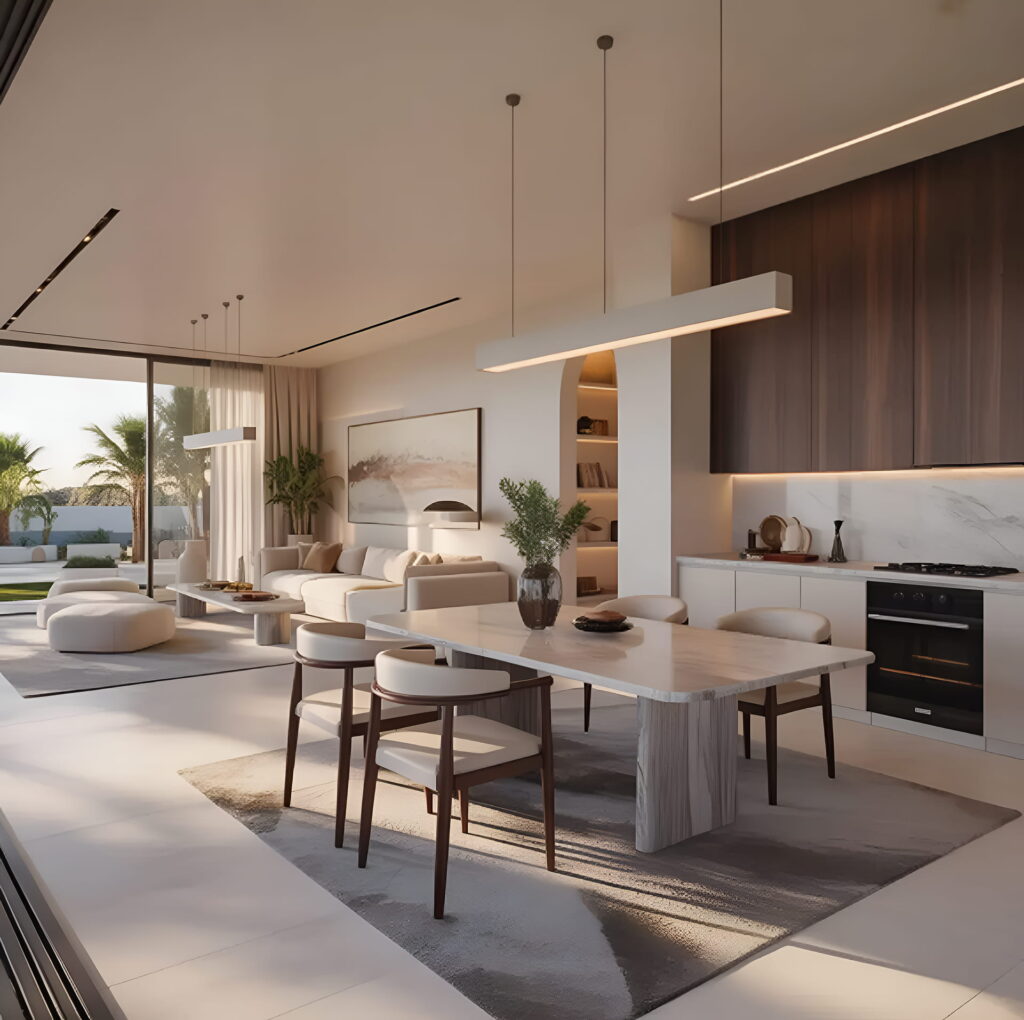Starting an interior fit-out project is an exciting step, but it often begins with a crucial question: should you manage the process yourself or hand over the entire responsibility to a single company? For many property owners, investing in a full fit-out can be the most efficient way to achieve a seamless result.
This decision between a partial and a turnkey interior fit-out approach will shape your entire experience, from budget and timeline to your personal involvement. Understanding the difference is key to a successful project that meets your expectations without unnecessary stress. This guide will break down both options clearly, helping you choose the path that is right for you.
What is a Turnkey Fit-Out Service?
A turnkey fit-out service is an all-in-one solution. The term “turnkey” means you can simply “turn the key” and walk into a completed, fully functional space. When you hire turnkey fit-out contractors in Dubai, you are hiring a single company to manage every single aspect of the project.
This company acts as the main point of contact, handling everything from the initial design concept and sourcing all materials to managing all the different subcontractors like electricians, plumbers, and carpenters. They also take care of the necessary permits, inspections, and final cleaning. Your role is primarily to approve designs and decisions along the way, making it a very hands-off experience.
What is a Partial Fit-Out Service?
A partial fit-out service, also known as a design and build or specific trade service, involves a more collaborative approach. In this model, you hire a company for specific parts of the project rather than the whole package. For example, you might hire one firm for the interior design and another for the actual construction work.
Alternatively, you might decide to act as your own project manager, hiring individual electricians, plumbers, and carpenters separately. This approach gives you a high level of control over each element and allows you to source materials yourself, but it also requires a significant amount of your time, effort, and project management skills.
Key Differences at a Glance
The main difference lies in responsibility and involvement. A turnkey service offers a single point of accountability. You have one contract and one team to communicate with, which simplifies the process immensely. A partial fit-out, on the other hand, decentralizes this responsibility.
You become the project manager, coordinating between different teams and suppliers. This can lead to challenges if one team’s schedule delays another’s. While turnkey projects often have a more predictable timeline, partial fit-outs can be more flexible, allowing you to phase the work according to your budget.
The Advantages of Choosing a Turnkey Fit-Out
The biggest advantage of a turnkey solution is convenience. It saves you an enormous amount of time and eliminates the stress of managing multiple vendors. These contractors have established relationships with suppliers and subcontractors, which can sometimes lead to better pricing and smoother workflow.
They also have extensive experience navigating local regulations, ensuring your project complies with all codes and obtains permits efficiently. With a fixed timeline and a single point of contact, project delays and communication gaps are minimized, leading to a more streamlined and predictable process from start to finish.
The Potential Drawbacks of a Turnkey Fit-Out
The primary drawback of a turnkey service is cost. Because the contractor is taking on all the management risk and responsibility, their fee will be higher to cover their overhead and project management expertise. Some clients also feel they have less direct control over every small detail, as they are relying on the contractor’s team to execute the vision.
There is a risk of less transparency in pricing if the contract is not detailed enough, so it is crucial to choose a reputable company that provides a clear and comprehensive breakdown of all costs involved.
The Advantages of Opting for a Partial Fit-Out
The most significant benefit of a partial fit-out is potential cost savings. By managing the project yourself or sourcing individual trades, you can avoid the main contractor’s management fee.
This approach also offers maximum control. You can hand-pick every material, fixture, and specialist based on your specific preferences and budget. It allows for great flexibility; you can complete the project in stages as funds become available. For individuals with construction knowledge or a strong desire to be deeply involved, this can be a very rewarding process.
The Challenges of a Partial Fit-Out
The challenges of a partial fit-out are substantial. It demands a major investment of your time and energy. You will need to create a project schedule, coordinate multiple teams, resolve disputes between contractors, and manage deliveries.
There is a high risk of delays and cost overruns if one trade is not finished on time, holding up the next. The biggest risk is the lack of a single point of accountability. If something goes wrong, such as an electrical issue blamed on the plumbing, it can be difficult to determine who is responsible for fixing it.
Making the Right Choice for Your Project
Your choice between turnkey and partial fit-out depends on three main factors: your budget, your time, and your expertise. If your priority is a hassle-free experience, you have a set budget for full-service management, and you lack the time or desire to manage the project, a turnkey solution is the best choice.
It is particularly advantageous for complex commercial projects or homeowners who want a guaranteed result. If you have a limited budget, possess project management skills, and have the time to dedicate to overseeing every detail, a partial fit-out can be a viable and cost-effective option.
Key Questions to Ask Before Deciding
Before making a final decision, ask yourself a series of important questions. How much time can I realistically commit each week to managing this project? Do I have the technical knowledge to understand construction sequences and quality standards? What is my total budget, and does it include a contingency fund for unexpected issues? How important is a firm completion date to me? Am I comfortable dealing with potential conflicts between different contractors? Honest answers to these questions will provide immense clarity and guide you toward the service model that aligns with your capabilities and expectations.
The Importance of a Detailed Contract
Regardless of which path you choose, a detailed contract is your most important tool for success. For a turnkey project, the contract should clearly outline the full scope of work, a detailed payment schedule linked to project milestones, a definitive timeline with a completion date, and a comprehensive list of all materials, including brands, models, and quantities.
For a partial fit-out, you will need separate contracts for each trade or supplier. Each contract should be equally detailed, specifying the exact work to be done, materials to be used, start and end dates, and warranty information to protect your investment.
Conclusion: Partnering for Your Project’s Success
Choosing between a turnkey and partial fit-out is about understanding your own role in the project’s journey. While a partial fit-out offers control, a turnkey service provides peace of mind and professional efficiency. For those seeking a seamless, high-quality result without the stress, partnering with an experienced firm is the ideal solution.
Rawaa Interiors specializes in delivering exceptional turnkey fit-out projects across Dubai, managing every detail from concept to completion. Let us handle the complexity while you enjoy the transformation. Contact us today at interiorsbyalrawaa@outlook.com or call +971 50 222 8146 / +971 52 934 3293 to discuss your vision.
Frequently Asked Questions
Can I switch from a partial to a turnkey approach midway through my project?
Yes, it is possible, but it can be complicated. A new contractor would need to assess the work completed, which may involve rectifying issues. This often leads to additional costs and delays, so it is best to decide on the approach before starting.
How do turnkey contractors typically structure their payment schedules?
Payment schedules are usually tied to project milestones. A common structure is a small initial deposit, followed by progressive payments after major stages like demolition, masonry, MEP installation, and then a final payment upon project handover and snagging list completion.
For a partial fit-out, what is the best order to hire the different trades?
The logical sequence begins with demolition and debris removal, followed by masonry and wall construction. Then, electrical and plumbing rough-ins are done, followed by plastering and painting. Flooring and ceiling work come next, with final fixture and furniture installation last.
What specific credentials should I look for when hiring a turnkey contractor in Dubai?
Look for a company with a valid trade license from the Dubai Department of Economic Development (DED), membership in industry bodies like the Association of Professional Interior Designers (APID), and a portfolio of completed projects similar to yours.
If I choose a partial fit-out, what is the most common bottleneck that causes delays?
The most frequent bottleneck is the poor coordination between trades. For example, if the electrical wiring is not completed on time, it will delay the plasterer who needs to close up the walls, which then pushes back the painter’s schedule.

